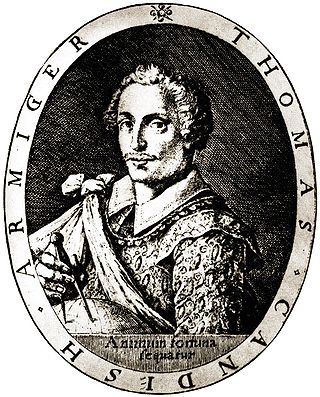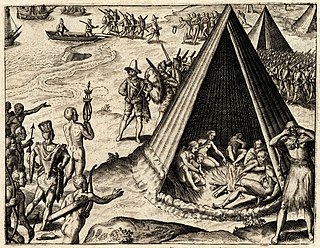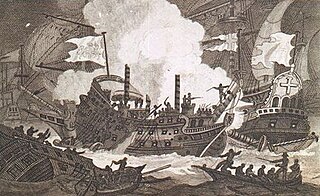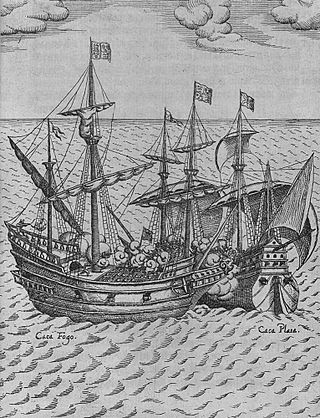
Sir Francis Drake was an English explorer and privateer best known for his circumnavigation of the world in a single expedition between 1577 and 1580. This was the first English circumnavigation, and third circumnavigation overall. He is also known for participating in the early English slaving voyages of his cousin, Sir John Hawkins, and John Lovell. Having started as a simple seaman, in 1588 he was part of the fight against the Spanish Armada as a vice-admiral.

Sir Thomas Cavendish was an English explorer and a privateer known as "The Navigator" because he was the first who deliberately tried to emulate Sir Francis Drake and raid the Spanish towns and ships in the Pacific and return by circumnavigating the globe. Magellan's, Loaisa's, Drake's, and Loyola's expeditions had preceded Cavendish in circumnavigating the globe. His first trip and successful circumnavigation made him rich from captured Spanish gold, silk and treasure from the Pacific and the Philippines. His richest prize was the captured 600-ton sailing ship the Manila Galleon Santa Ana. He was knighted by Queen Elizabeth I of England after his return. He later set out for a second raiding and circumnavigation trip but was not as fortunate and died at sea at the age of 31.

Galleons were large, multi-decked sailing ships developed in Portugal and Spain and first used as armed cargo carriers by Europeans from the 16th to 18th centuries during the age of sail and were the principal vessels drafted for use as warships until the Anglo-Dutch Wars of the mid-1600s. Galleons generally carried three or more masts with a lateen fore-and-aft rig on the rear masts, were carvel built with a prominent squared off raised stern, and used square-rigged sail plans on their fore-mast and main-masts.

Sir Christopher Hatton KG was an English politician, Lord Chancellor of England and a favourite of Elizabeth I of England. He was one of the judges who found Mary, Queen of Scots guilty of treason.

New Albion, also known as Nova Albion, was the name of the continental area north of Mexico claimed by Sir Francis Drake for England when he landed on the North American west coast in 1579. This claim became the justification for English charters across America to the Atlantic coast and soon influenced further national expansion projects on the continent. Drake's landing site has been identified as Drake's Bay, which is part of Point Reyes National Seashore.

Revenge was an English race-built galleon of 46 guns, built in 1577 and captured by the Spanish in 1591, sinking soon afterwards. She was the first of 13 English and Royal Navy ships to bear the name.
Thomas Doughty was an English nobleman, soldier, scholar and personal secretary of Christopher Hatton. His association with Francis Drake, on a 1577 voyage to raid Spanish treasure fleets, ended in a shipboard trial for treason and witchcraft, and Doughty's execution.

Nuestra Señora de la Concepción was a 120-ton Spanish galleon that sailed the Peru–Panama trading route during the 16th century. This ship has earned a place in maritime history not only by virtue of being Sir Francis Drake's most famous prize, but also because of her colourful nickname, Cagafuego ("fireshitter").

Sir Francis Drake is a 1961–1962 British adventure television series starring Terence Morgan as Sir Francis Drake, commander of the sailing ship the Golden Hind. As well as battles at sea and sword fights, the series also deals with intrigue at Queen Elizabeth's court.

The Golden Hinde is a mountain located in the Vancouver Island Ranges on Vancouver Island, British Columbia, Canada. At 2,195 metres (7,201 ft), it is the highest peak on the island. The peak is popular with experienced backcountry-climbers, having been first ascended in 1913. The mountain is made of basalt which is part of the Karmutsen Formation.

Bonaventure was a 47-gun galleon purchased by the Royal Navy in 1567. She was the third vessel to bear the name. She was commanded by Sir Francis Drake during his 1587 attack on Cadiz, and a year later was part of the fleet to face the Spanish Armada.
Drake's Venture is a 1980 film depiction of Francis Drake's voyage of circumnavigation. Produced by Westward Television to commemorate the 400th anniversary of the event, it nevertheless focuses on the voyage's most controversial aspect, the execution of the gentleman Thomas Doughty for mutiny. The film has only been aired twice: once in the UK on 28 December 1980, and once in the US, on Masterpiece Theatre, 27 March 1983.

The Sea Dogs were a group of English privateers and explorers authorised by Queen Elizabeth I to raid England's enemies, whether they were formally at war with them or not. Active from 1560 until Elizabeth's death in 1603, the Sea Dogs primarily attacked Spanish targets both on land and at sea, particularly during the Anglo-Spanish War. Members of the Sea Dogs, including Sir John Hawkins and Sir Francis Drake, also engaged in illicit slave trading with Spanish colonies in the Americas.

Francis Fletcher was a priest of the Church of England who accompanied Sir Francis Drake on his circumnavigation of the world from 1577 to 1580 and kept a written account of it.

The Golden Hinde is a full-size replica of the Golden Hind. She was built using traditional handicrafts at Appledore, in Devon. She has travelled more than 140,000 mi (230,000 km), a distance equal to more than five times around the globe. Like the original ship, she has circumnavigated the globe.
The Golden Hind was an English galleon captained by Sir Francis Drake.
Vice-Admiral Sir John Wynter or Winter (1555–1638) was an explorer and naval officer in the English Navy Royal. As a ship's captain in the Drake expedition of 1577-1580, he was the first European to cross the Strait of Magellan from west to east.

The race-built galleon was a type of war ship built in England from 1570 until about 1590.

Francis Drake's circumnavigation, also known as Drake's Raiding Expedition, was an important historical maritime event that took place between 15 December 1577 and 26 September 1580. The expedition was authorised by Queen Elizabeth I and consisted of five ships led by Francis Drake. Termed a 'voyage of discovery', it was in effect an ambitious covert raiding voyage and the start of England's challenge to the global domination of Spain and Portugal.

Thomas Cavendish's circumnavigation was a voyage of raid and exploration by English navigator and sailor Thomas Cavendish which took place during the Anglo–Spanish War between 21 July 1586 and 9 September 1588. Following in the footsteps of Francis Drake who circumnavigated the globe, Thomas Cavendish was influenced in an attempt to repeat the feat. As such it was the first deliberately planned voyage of the globe.


















